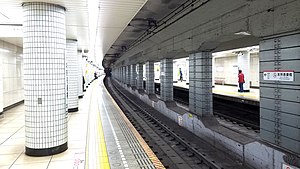| A19 Honjo-azumabashi Station 本所吾妻橋駅 | |||||||||||
|---|---|---|---|---|---|---|---|---|---|---|---|
 Platform level of Honjo-azumabashi Station. Platform level of Honjo-azumabashi Station. | |||||||||||
| General information | |||||||||||
| Location | 3 Azumabashi, Sumida City, Tokyo Japan | ||||||||||
| Operated by | |||||||||||
| Line(s) | A Asakusa Line | ||||||||||
| Platforms | 2 side platforms | ||||||||||
| Tracks | 2 | ||||||||||
| Construction | |||||||||||
| Structure type | Underground | ||||||||||
| Other information | |||||||||||
| Station code | A-19 | ||||||||||
| History | |||||||||||
| Opened | 4 December 1960; 64 years ago (1960-12-04) | ||||||||||
| Services | |||||||||||
| |||||||||||
Honjo-azumabashi Station (本所吾妻橋駅, Honjo-azumabashi-eki) is a subway station on the Toei Asakusa Line, operated by the Toei. It is located in Sumida, Tokyo, Japan. Its number is A-19.
Station layout
Honjo-azumabashi Station has two side platforms serving two tracks.
Platforms
| 1 | A Asakusa Line | for Nihombashi, Sengakuji, and Nishi-magome KK Keikyū Main Line for Shinagawa, Haneda Airport (International Terminal and Domestic Terminal), and Misakiguchi |
| 2 | A Asakusa Line | for Oshiage KS Keisei Main Line for Keisei Funabashi, Keisei Narita, and Narita Airport (Terminal 2·3 and Terminal 1) KS Narita Sky Access Line for Narita Airport HS Hokusō Line for Imba Nihon-idai SR Shibayama Railway Line for Shibayama-Chiyoda |
History
| This section does not cite any sources. Please help improve this section by adding citations to reliable sources. Unsourced material may be challenged and removed. (February 2017) (Learn how and when to remove this message) |
Honjo-azumabashi Station opened on December 4, 1960, as a station on Toei Line 1. In 1978, the line was given its present name.
In the 2015 data available from Japan’s Ministry of Land, Infrastructure, Transport and Tourism, Honjo-azumabashi → Asakusa was one of the train segments among Tokyo's most crowded train lines during rush hour.
Surrounding area
The station serves the Azumabashi bridge neighborhood. Nearby are the local police station, the Sumida Ward office (city hall), and the headquarters of Asahi Breweries.
References
- ^ "Honjo-azumabashi". Toei Transportation. Retrieved January 15, 2024.
- "Most Crowded Rush Hour Train Lines in Tokyo". Blog. 2017-05-04. Retrieved 2024-08-11.
35°42′30.96″N 139°48′16.75″E / 35.7086000°N 139.8046528°E / 35.7086000; 139.8046528
| Stations of the Toei Asakusa Line | ||
|---|---|---|
| A | |
This Tokyo railroad station–related article is a stub. You can help Misplaced Pages by expanding it. |



